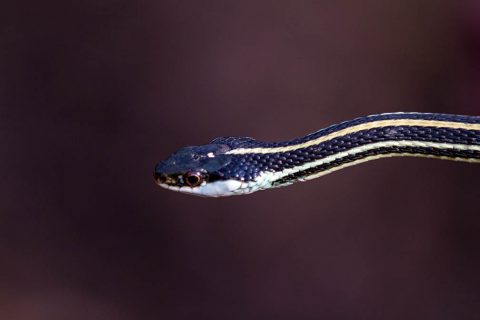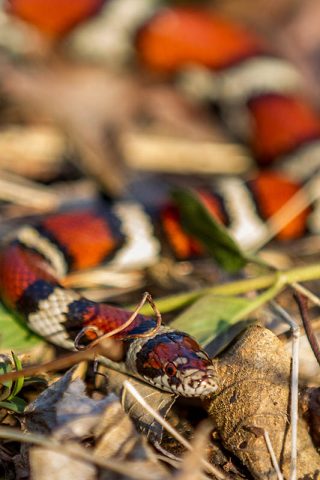Written by Spc. Patrick Kirby
40th Public Affairs Detachment
 Fort Campbell, KY – “Snakes are unfairly persecuted in ways that are not tolerated for other animals, either domestic or wildlife.” said Dr. Chris Gienger, a herpetology professor at Austin Peay State University.
Fort Campbell, KY – “Snakes are unfairly persecuted in ways that are not tolerated for other animals, either domestic or wildlife.” said Dr. Chris Gienger, a herpetology professor at Austin Peay State University.
Spring is here and with it comes warmer weather. Families begin going out on hikes and enjoying the outdoors. Those people enjoying the outdoors should be mindful of the wildlife on and around Fort Campbell as they’re exploring. They should make sure to know what to look for while on the trail.
Herpetology is the branch of zoology which deals with the study of reptiles and amphibians such as snakes, turtles, and iguanas.

Snakes are largely misunderstood, they would rather just be left alone, to do their own thing. However, as a species, snakes have gotten a bad reputation as being dangerous, deadly, and destructive reptiles; leading most people to kill on sight.
“Can you think of another group where one of the first thoughts upon encountering an unknown individual is to kill it?” asked Dr. Gienger. “Imagine if a stray dog was found walking through a neighborhood and somebody killed it just to make sure it wasn’t dangerous and didn’t harm anyone. People would be furious. It is largely lack of education and fear that make snakes so maligned. They are important parts of healthy ecosystems and part of our shared natural heritage. It is only through common sense and education that humans and snakes can avoid conflict.”
Snakes are a vastly important part of our ecosystem and play a role in keeping rodent population down.

“Snakes are exceptional at finding and consuming small rodents and play an important role in regulating small vertebrate populations in ecosystems,” said Dr. Gienger. “They are just one small but essential part of a healthy and functioning ecosystem. If you think of them like a rivet on the wing of an airplane; a very small but essential part of a whole. Removal of one or two of those parts likely isn’t going to be noticed, but removal of several or most of those essential parts means the certain collapse of the system.”
Tennessee is home to 34 species of snakes, only four of which are venomous. Of those four, only three are found on Fort Campbell: the Copperhead, the Timber Rattlesnake, and the Western Pygmy Rattlesnake. There are no Cottonmouths on post.
However there is a snake, the Northern Watersnake, which looks very similar to the Cottonmouth, leading to the frivolous killing of many Northern Watersnakes.
“A lot of Watersnakes get killed by people who think, ‘Oh, a Cottonmouth!’ but Cottonmouths are further west of us,” said Andy Riggs, a biologist for Fort Campbell Fish and Wildlife. “If it’s on Fort Campbell, it’s not a Cottonmouth.”
It is best just to leave all snakes alone, but some ways to tell the venomous snakes apart from harmless snakes is by the shape of their heads. If the head is a triangle shape, it’s venomous. If the eyes have slits in them, it’s venomous. If the body and the head have a clear separation and don’t look to be one full part, it’s venomous.
“Copperheads are docile; they would much rather lay motionless and let you just walk on by,” said Riggs. “The thing is, they realize that the organism they’re striking is so big that they aren’t going to take it down. It isn’t worth their fitness. Most strikes result from a defensive reaction to being stepped on.”
With spring here, Copperheads will begin breeding, causing them to be more aggressive.
A juvenile Copperhead is easily identifiable by their bright neon yellow tip on the end of their tails.
Some things to keep in mind while out on the trail would be that Copperheads are ambush predators. If crossing a log or rock, step on top of them first, then off the other side, not just over it. There may be a Copperhead waiting to strike on the other side.
“Killing snakes to kill ‘em doesn’t make any sense!” Riggs exclaimed. “If people realized how much rodent and insect control snakes create for us, they may think ‘well maybe we should leave them alone”’.
Moreover, it is illegal to kill snakes in Tennessee, venomous or non-venomous. The only rare exception is made for someone who feels genuinely threatened by a snake or if livestock is being threatened. According to Tennessee Code 70-4-102, it is always illegal to go out into the wild and kill a snake in its natural Tennessee habitat.
Although there are venomous snakes on Fort Campbell, the chance of an encounter is lower when they are left alone.
“It is very rare that we receive snake bite victims here on post,” Maj. Todd Bialowas Chief of Blanchfield Army Community Hospital emergency center. “It’s just not something we get here, we’re very lucky on that count.













